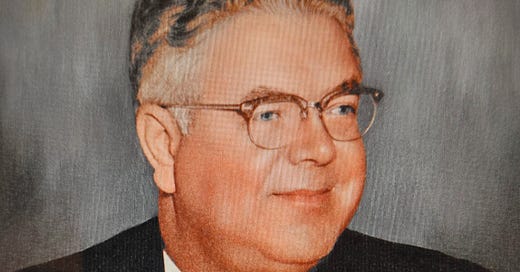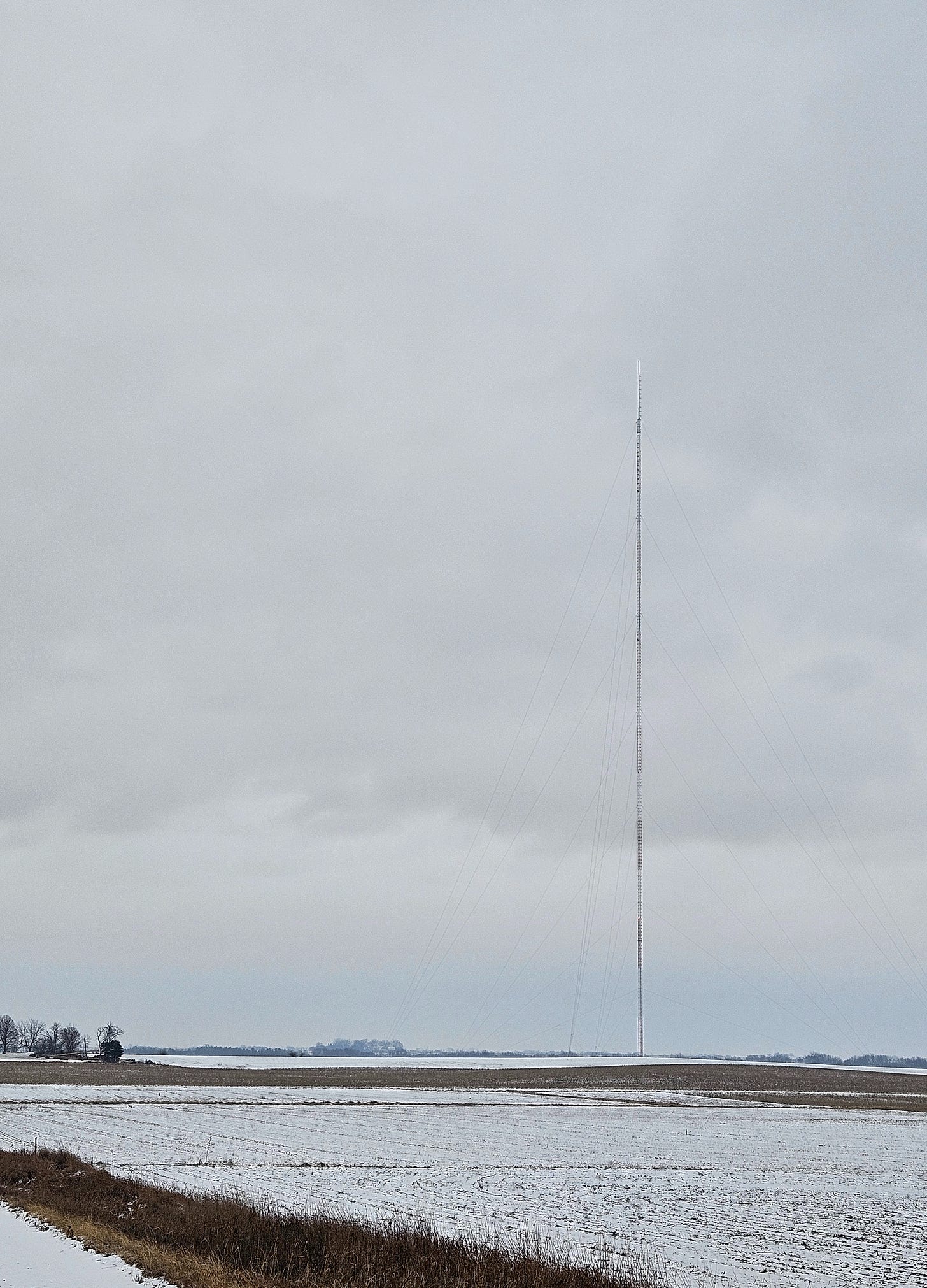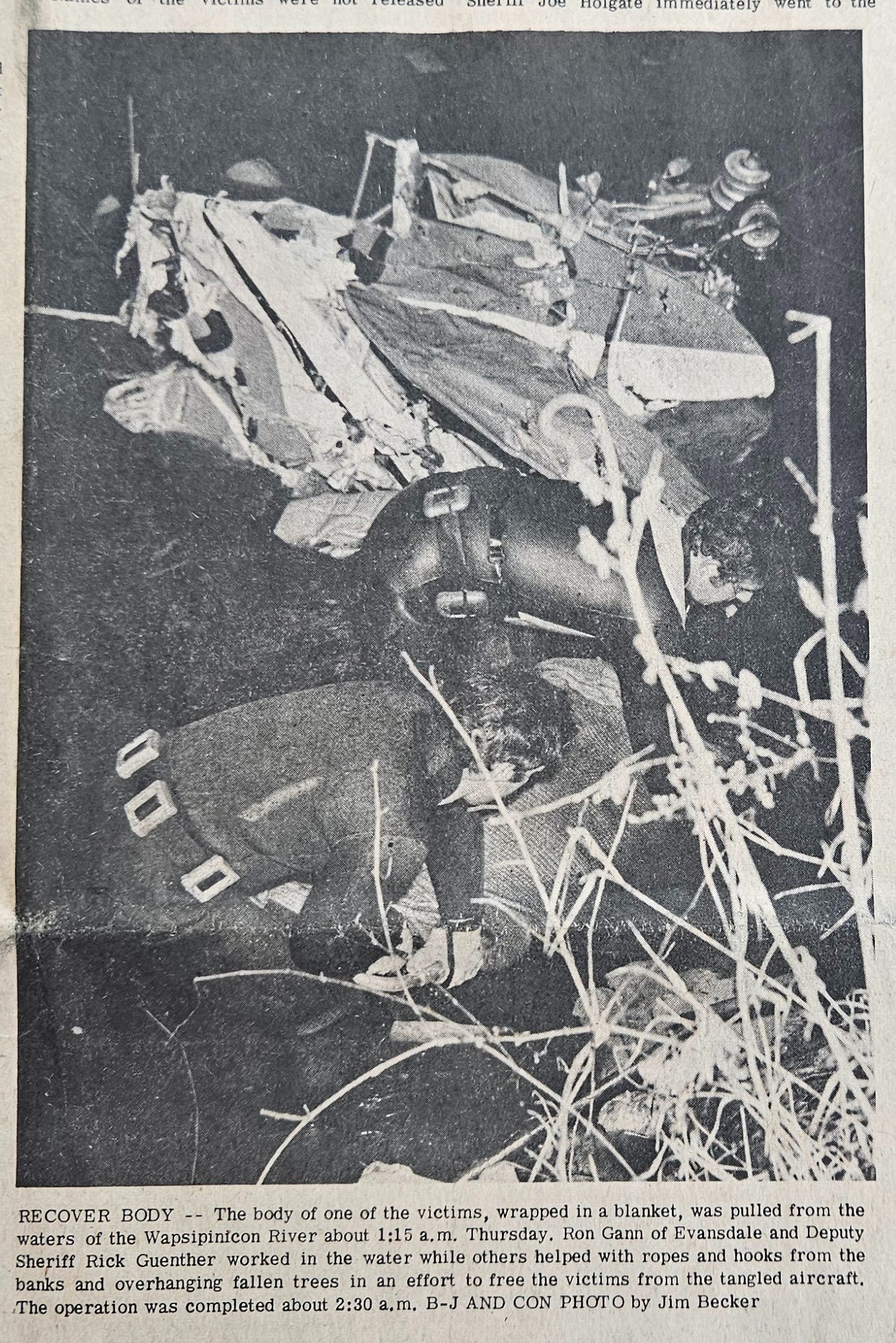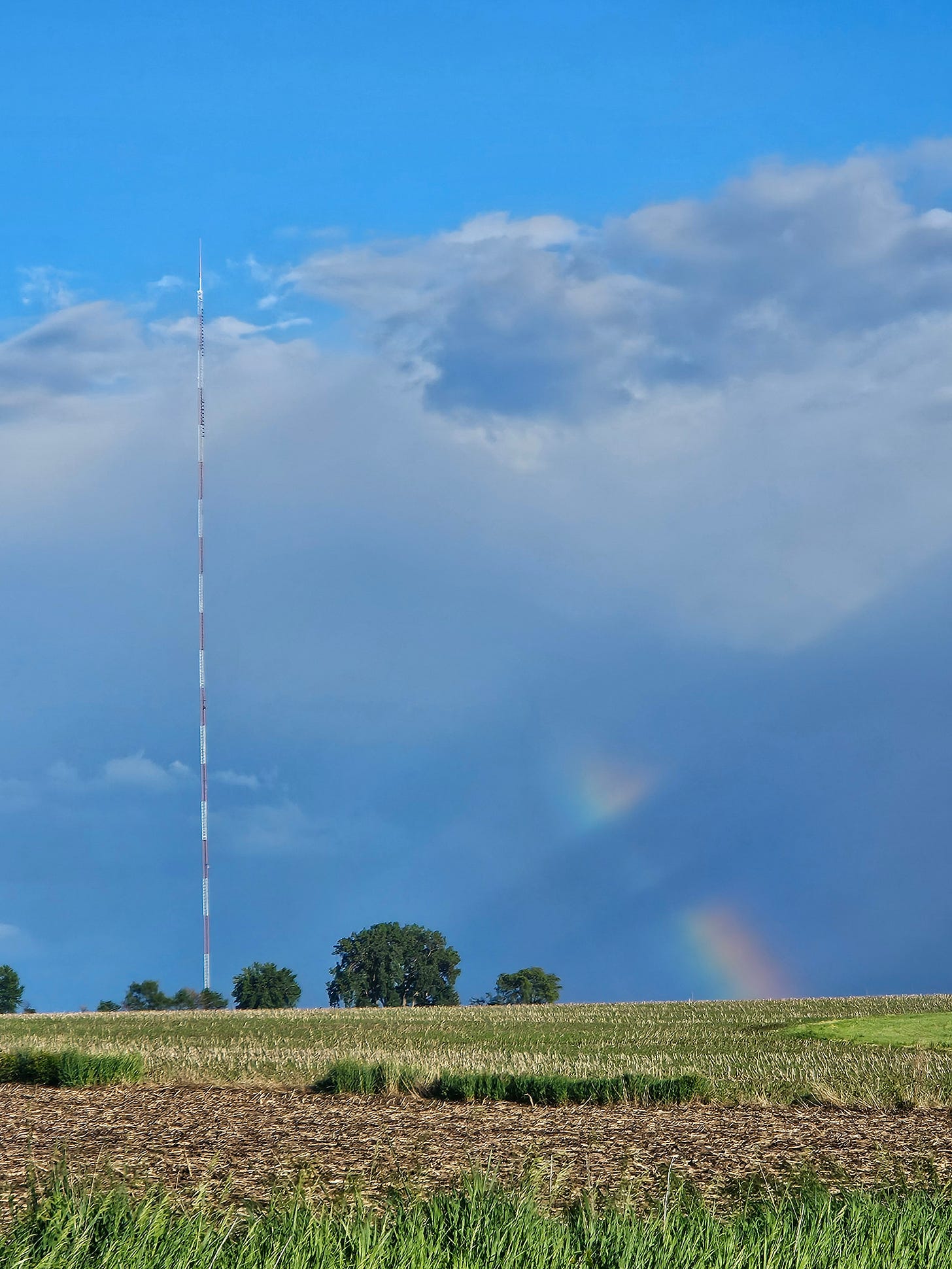KWWL-TV's 1983 Tower Collapse and Two Other Tragedies
Several fatalities were associated with the 2000 ft tower near my hometown, none of them related to the tower tumbling down.
Every day, about 50,000 vehicles travel the Interstate 35 corridor between Ankeny and Ames. Several miles west of the freeway near the bedroom town of Alleman, four towers rise high above cornfields to provide television, radio, and cell phone services to over a million central Iowans.
Built in the early 1970s, TV towers for WHO and KCCI are 2000 feet tall. A nearby tower tops out at 1999 feet and the fourth one reaches 1539 feet. Combined, that’s nearly 1½ miles of steel stretching into the prairie sky.
I wonder how often drivers think about the challenges of building such colossal projects? Or the dangers involved in their construction?
Do they realize three of those towers are the ninth and ten tallest structures in the world?
–
I grew up in northeast Iowa, about halfway between Waterloo and Cedar Rapids. Higher terrain made the area ideal for building TV towers. Some folks (well, I do) refer to my hometown of Rowley as “the Alleman of Northeast Iowa.”
Three towers were built within five miles of my parent’s home between 1956 and 1968. They have all fallen over the years, including the KCRG collapse in 1973 that killed five workers. I covered the construction and destruction of the KCRG tower in two earlier posts. I also wrote earlier about the WMT tower collapse during its construction in December, 1956 (no casualties, fortunately).
Two miles on level ground north of Rowley stands the 2000 foot tall KWWL -TV tower. Heavy icing in November, 1983 caused it to crash. There were no casualties that day, but two other tragedies are associated with the tower site.
–
There was a mad rush for television licenses in the economic boom following World War 2. After taking time to sort through pending licensees and frequency assignments, the FCC finally awarded new local television licenses to three different eastern Iowa companies. Each station was on the air within three months of one another in late 1953.
WMT-TV in Cedar Rapids was first to go live on Sept 30th at 11:35am, with station manager William Quarton giving a brief talk before coverage switched to the 1953 World Series between the Brooklyn Dodgers and the New York Yankees. The CBS affiliate had a special arrangement with the NBC network to air the games.
ABC affiliate KCRI went live on Oct 15, 1953. In July 1954, the Cedar Rapids Gazette took over ownership and renamed the station KCRG.
A two-year battle for a pending Waterloo broadcast license was resolved in September, 1953. Ralph McElroy, owner of Black Hawk Broadcasting, won the rights to a television frequency when Sonderling Broadcasting (owner of KXEL radio) withdrew their request.
Waterloo broadcasting pioneer R J McElroy. Full disclosure—the McElroy Foundation provided a scholarship for me while attending UNI, for which I am grateful.
McElroy founded KWWL radio in 1947 with $45,000 of used broadcasting equipment. Once he was awarded a TV license, McElroy didn’t waste any time. He flew to New York, lined up an affiliation agreement with NBC, ordered broadcasting equipment to be shipped to Waterloo ASAP, and was on the air by Thanksgiving. Live opening remarks were followed by several days of test patterns, and regular programming began airing that Sunday.
KWWL-TV went from 30,000 watts in 1953 to 100,000 watts on Sept. 15, 1954. The station added color broadcasts that same month, transmitting from a tower south of Jesup. Their studio moved from highway 20 east to a former Overland car dealership building on East 4th St in downtown Waterloo in 1958.
KWWL’s original broadcasting tower (and current backup tower) south of Jesup, Iowa
In early 1967, television stations KWWL and KCRG announced a joint plan to build a 2000 ft tower four miles south of Rowley and four miles west of Walker. Construction began in mid-May and transmission was in full service on August 30, 1967…but only for KCRG (five men were killed when the tower collapsed on October 3, 1973. Read more about that tragic day at https://barnstormingbrain.substack.com/p/four-tv-towers-within-five-miles)
The FCC ruled the KWWL antenna couldn’t be added to the KCRG tower due to mileage separation requirements with WGEM-TV in Quincy, Illinois which shared channel 7’s frequency.
In early January 1968, Black Hawk Broadcasting revealed plans to build a 2000-foot for KWWL two miles north of Rowley. It would double the size of their existing tower near Jesup. Vice-president of engineering Ed Tink estimated construction costs at about $500,000.
A brief article in the August 31, 1968 Gazette noted that the KWWL tower was ready. Channel 7 would be off the air for a day or so while transmission equipment was moved to Rowley.
–
Fall 1973 wasn’t just bad for KCRG-TV; the five-year old KWWL tower may have contributed to a fatal airplane crash. The November 16th Independence Bulletin-Journal reported two people were killed when their small plane went down near the tower. The Gazette later identified the victims as a father and his 13-year old daughter from Kansas City.
Wreckage was strewn for several miles and within a quarter mile of the tower. After a twelve-hour search lasting well past midnight, the plane’s cockpit was found by two coon hunters in the Wapsipinicon River.
Authorities speculated the pilot may have had mechanical trouble and hit a KWWL guy wire while flying through a thunderstorm and heavy fog. (Two months earlier, singer Jim Croce and five others were killed in a small plane crash in Louisiana. He remains one of my favorite singers).
I was a junior at Independence High School when the local plane crashed. My brother and I were two weeks into a very productive trapping season. The weather was eerie for November–warm, cloudy, and mid-summer muggy.
I think later my dad found a small piece of the plane while deer hunting along the Wapsi.
–
“Record November blizzard freezes travel” headlined the Gazette on Tuesday, November 29, 1983. Snow drifts up to 8 ft tall–some glazed with a half-inch of ice–paralyzed the Great Plains on Thanksgiving weekend. As the storm front moved into eastern Iowa, heavy ice accumulated on the Rowley towers.
I worked at KUNI radio in Cedar Falls at the time, and our signal was transmitted from the KCRG tower. Heavy ice build-up was causing the top of the 2000-ft tower to lean several feet off center.
The Gazette later reported 9 inches of ice covered the tower, yet it remained standing.
As the crow flies, the KWWL tower was about six miles north of KCRG’s. After guy wires were coated with two inches of ice, they snapped. The channel 7 tower crashed to the cornfields at 4:36 on Sunday afternoon.
Two inches of ice coating guy wires like these on the KWWL tower caused it to crash on November 27, 1983.
KWWL Vice President Grant Price said a chief engineer had driven to Rowley prior to the collapse. “He said the upper half of the tower was obscured by low hanging clouds. Then he saw it buckle.”
The station was back on the air by 1am Monday, operating at reduced power from the 1000-ft tall Jesup tower. KWWL’s Harry Slife estimated a 10-15% reduction in viewership coverage, leading to advertising revenue loss in addition to the estimated $3.5 million reconstruction cost.
Basketball fans in the far reaches of KWWL’s reduced signal were disappointed by not being able to watch their Iowa Hawkeye games. After Black Hawk Broadcasting sold the station to AFLAC, the new company created the Iowa Sports Network. In the early 1980’s, NBC programming was preempted by men’s Iowa Hawkeye Basketball. Marlyce King in distant McGregor lamented “we have chips and dip and no place to go. We can’t even hear Bob Hogue say ‘oh my!’”
The Signal Newsletter, published by KWWL-TV, reported on Dec 21, 1983 that Stainless Inc. of North Wales, PA had been awarded the contract to rebuild the tower. “The new tower will also be built with heavy ice loading capabilities,” said chief engineer Jim Ohmestede. He added that 315 tons of steel and 7 ½ miles of guy wire would be shipped to Rowley the following spring.
When asked if it were possible to heat the tower to prevent icing, Ohmestede said 300,000 watts of power would be needed just to heat the guy wires. “You could electrically heat twenty homes with that much power,” he added. Heating the tower would require another 100,000 watts. Current traveling through the cables would also cause considerable signal interference.
–
Construction on the new Rowley tower began on June 30, 1984.
In mid-August, a man was killed while working on the antenna at the very top of the 2000-foot tower after he fell about 50 ft onto the tower platform. Although Joe Devans, 29, had been wearing a safety belt, there was speculation he hadn’t properly fastened it.
Sobering news in the Independence Bulletin Journal, August 1984
A picture of the icy KWWL antenna reaching 2000 ft above Buchanan county, Dec 2024.
Devans was rescued from the tower platform with a lift system owned and operated by Tower King, contractor for the project. He was pronounced dead at People’s Hospital in Independence.
The accident happened on Sunday, August 12, at 10:10am. Dad told me multiple sirens interrupted the church sermon that morning.
The tragedy made the front page of the Gazette. Below the fold, it was next to a story about a missing Des Moines paperboy, Eugene Wade Martin.
—
According to Wikipedia, Dubai’s Burj Khalifa skyscraper is the world’s tallest manmade structure at 2722 feet–rising over a half mile above the Persian Gulf! Tied for ninth place in height are the KWWL, KCCI, and WHO broadcast towers. Eighteen other guyed mast TV towers also reach 2000 feet in elevation.
Other than a Wisconsin tower rebuilt in 2012, the most recent 2000-ft tower in the United States was constructed in 2006. With advancements in telecommunications and the diminished influence of over-the-air television broadcasting, will any other towers that tall be built?
A partial rainbow behind the KWWL-TV tower near Rowley, IA, May 2024.
–
This is my fourth post in a series I call “Tales of Four TV Towers that have Fallen within Five Miles of Places I’ve Lived.”
In my next installment, I’ll dial the wayback machine to Fort Dodge, Iowa, in 1977. That’s when I was a broadcasting student at Iowa Central Community College. A tornado ripped through our campus, weakening the KVFD-TV tower that was a few hundred feet from our dorm. It was deliberately toppled about a week later.
And I missed seeing both the tornado and the tower collapse!
SOURCES:
https://www.thegazette.com/history/time-machine-3-months-3-tv-stations/
https://en.wikipedia.org/wiki/KWWL_(TV)
Cedar Rapids Gazette, 8/13/1984; 12/11/1983; 11/29/1983; 11/28/1983; 11/15/1973.
Independence Bulletin-Journal Conservative, 8/13/1984; 11/29/1983; 12/2/1983; 11/16/1973
The Signal Newsletter, KWWL-TV, 12/21/1983.
https://en.wikipedia.org/wiki/List_of_tallest_structures
https://www.mcelroytrust.org/our-history










